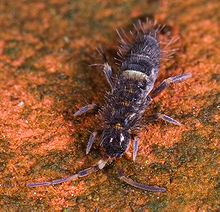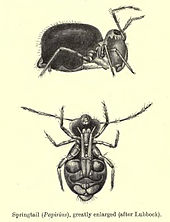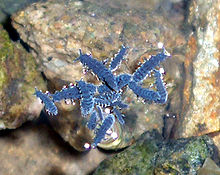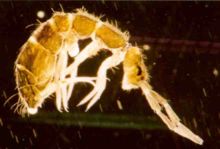- Springtail
-
Springtails
Temporal range: Early Devonian–Recent
Orchesella cincta Scientific classification Kingdom: Animalia Phylum: Arthropoda Subphylum: Hexapoda Class: Entognatha (but see text) Subclass: Collembola
Lubbock, 1870Orders - Entomobryomorpha
- Poduromorpha
- Symphypleona
- Neelipleona (disputed)
Synonyms [1] - Oligentoma
- Oligoentoma
Springtails (Collembola) form the largest of the three lineages of modern hexapods that are no longer considered insects (the other two are the Protura and Diplura). Though the three orders are sometimes grouped together in a class called Entognatha because they have internal mouthparts, they do not appear to be more closely related to one another than they all are to insects, which have external mouthparts.
Some DNA sequence studies[2][3][4] suggest that Collembola represent a separate evolutionary line from the other Hexapoda, but others disagree;[5] this seems to be caused by widely divergent patterns of molecular evolution among the arthropods.[6] The adjustments of traditional taxonomic rank for springtails reflects the incompatibility of traditional groupings with modern cladistics: when they were included with the insects, they were ranked as an order; as part of the Entognatha, they are ranked as a subclass. If they are considered a basal lineage of Hexapoda, they are elevated to full class status.
Contents
Description
Members of Collembola are normally less than 6 millimeters (0.24 in) long, have six or fewer abdominal segments and possess a tubular appendage (the collophore or ventral tube) with eversible vesicles, projecting ventrally from the first abdominal segment. The Poduromorpha and Entomobryomorpha have an elongated body, while the Symphypleona have a globular body. Collembola lack a tracheal respiration system, which forces them to respire through a porous cuticle, to the notable exception of Sminthuridae which exhibit a rudimentary, although fully functional, tracheal system.[7]
Most species have an abdominal, tail-like appendage, the furcula, that is folded beneath the body to be used for jumping when the animal is threatened. It is held under tension by a small structure called the retinaculum and when released, snaps against the substrate, flinging the springtail into the air. All of this takes place in as little as 18 milliseconds.[8]
Systematics and evolution
Traditionally, the springtails were divided into the orders Arthropleona, Symphypleona and occasionally also Neelipleona. The Arthropleona were divided into two superfamilies, the Entomobryoidea and the Poduroidea. But actually, these two and the Symphypleona form three lineages, each of which is equally distant from the other two. Thus, the Arthropleona are abolished in modern classifications, and their superfamilies are raised in rank accordingly, being now the Entomobryomorpha and the Poduromorpha. Technically, the Arthropleona are thus a partial junior synonym of the Collembola. The term "Neopleona" is essentially synonymous with Symphypleona + Neelipleona.
The Neelipleona were originally seen as a particular advanced lineage of Symphypleona, based on the shared global body shape. But the global body of Neelipleona is realised in a completely different way than in Symphypleona. Subsequently, the Neelipleona were considered as being derived from the Entomobryomorpha. But analysis of 18S and 28S rRNA sequence data suggests that they form the most ancient lineage of springtails, which would explain their peculiar apomorphies.[5]
Springtails are attested to since the Early Devonian.[9] The fossil from 400 million years ago, Rhyniella praecursor, is the oldest terrestrial arthropod, and was found in the famous Rhynie chert of Scotland. Given its morphology resembles extant species quite well, the radiation of the Hexapoda can be situated in the Silurian, 420 million years ago or more.[10]
Ecology
Distribution
Springtails are cryptozoa frequently found in leaf litter and other decaying material,[11] where they are primarily detritivores and microbivores, and one of the main biological agents responsible for the control and the dissemination of soil microorganisms.[12]
"Snow flea"
 A species of Sminthurinae (Symphypleona: Sminthuridoidea: Sminthuridae)
A species of Sminthurinae (Symphypleona: Sminthuridoidea: Sminthuridae)
In sheer numbers, they are reputed to be one of the most abundant of all macroscopic animals, with estimates of 100,000 individuals per cubic meter of topsoil, essentially everywhere on Earth where soil and related habitats (moss cushions, fallen wood, grass tufts, ant and termite nests) occur; only nematodes, crustaceans, and mites are likely to have global populations of similar magnitude, and each of those groups except mites is more inclusive: though taxonomic rank cannot be used for absolute comparisons, it is notable that nematodes are a phylum and crustaceans a subphylum. Most springtails are small and difficult to see by casual observation, but one springtail, the so-called snow flea (Hypogastrura nivicola), is readily observed on warm winter days when it is active and its dark color contrasts sharply with a background of snow.[13]
In addition, a few species routinely climb trees and form a dominant component of canopy faunas, where they may be collected by beating or insecticide fogging.[14][15] These tend to be the larger (>2 mm) species, mainly in the genera Entomobrya and Orchesella, though the densities on a per square meter basis are typically 1–2 orders of magnitude lower than soil populations of the same species. In temperate regions, a few species (e.g. Anurophorus spp., Entomobrya albocincta, Xenylla xavieri, Hypogastrura arborea) are almost exclusively arboreal. In tropical regions a single square meter of canopy habitat can support many species of Collembola.[8]
The main ecological factor driving the local distribution of species is the vertical stratification of the environment: in woodland a continuous change in species assemblages can be observed from tree canopies to ground vegetation then to plant litter down to deeper soil horizons.[16] This is a complex factor embracing both nutritional and physiological requirements, together with probable species interactions. Some species have been shown to exhibit negative[14] or positive[17] gravitropism, which adds a behavioural dimension to this still poorly understood vertical segregation.
As a group, springtails are highly sensitive to desiccation, because of their tegumentary respiration. The gregarious behaviour of Collembola, mostly driven by the attractive power of pheromones excreted by adults,[18] gives more chance to every juvenile or adult individual to find suitable, better protected places, where desiccation could be avoided and reproduction rate could be kept at an optimum. Sensitivity to drought varies from species to species and increases during ecdysis.[19] Given that springtails are moulting repeatedly during their entire life (an ancestral character in Hexapoda) they spend much time in concealed micro-sites where they can find protection against desiccation and predation during ecdysis. The high humidity environment of many caves also favours springtails and there are numerous cave adapted species.[20][21]
 Anurida maritima on water
Anurida maritima on water
The horizontal distribution of springtail species is affected by environmental factors which act at the landscape scale, such as soil acidity, moisture and light.[16] Requirements for pH can be reconstructed experimentally.[22] Altitudinal changes in species distribution can be at least partly explained by increased acidity at higher elevation.[23] Moisture requirements explain why some species cannot live aboveground (vertical stratification), but also why some epigeal springtails are always found in the vicinity of ponds and lakes, such as the hygrophilous Isotomurus palustris. Adaptive features, such as the presence of a fan-like wettable mucro, allow some species to move at the surface of water (Sminthurides aquaticus, Sminthurides malmgreni). Podura aquatica, a unique representative of the family Poduridae (and one of the first springtails to have been described by Linnaeus), spends its entire life at the surface of water, its wettable eggs dropping in water until the non-wettable first instar hatches then surfaces.[24]
In a variegated landscape, made of a patchwork of closed (woodland) and open (meadows, cereal crops) environments, most soil-dwelling species are not specialized and can be found everywhere, but most epigeal and litter-dwelling species are attracted to a particular environment, either forested or not.[16][25] As a consequence of dispersal limitation, landuse change, when too rapid, may cause the local disappearance of slow-moving, specialist species.[26]
Relationship with humans
Springtails are well known as pests of some agricultural crops. Sminthurus viridis, the 'lucerne flea', has been shown to cause severe damage to agricultural crops,[27] and is considered as a pest in Australia.[28][29] Also Onychiuridae are known to feed on tubers and to damage them to some extent.[30] However, by their capacity to carry spores of mycorrhizal fungi and mycorrhiza-helper bacteria on their tegument, soil springtails play a positive role in the establishment of plant-fungal symbioses and thus are beneficial to agriculture.[31] They also contribute to controlling plant fungal diseases through their active consumption of mycelia and spores of damping-off and pathogenic fungi.[32][33] It has been suggested that they could be reared to be used for the control of pathogenic fungi in greenhouses and other indoor cultures.[34][35]
Various sources and publications have suggested that some springtails may parasitize humans, but this is entirely inconsistent with their biology, and no such phenomenon has ever been scientifically confirmed, though it has been documented that the scales or hairs from collembolans can cause irritation when rubbed onto the skin.[36] They may sometimes be abundant indoors in damp places such as bathrooms and basements, and incidentally found on one's person.
More often, claims of persistent human skin infection by springtails may indicate a neurological problem, such as Morgellons Syndrome, or delusory parasitosis, a psychological rather than entomological problem. Researchers themselves may be subject to psychological phenomena. For example, a publication in 2004 claiming that springtails had been found in skin samples was later determined to be a case of pareidolia; that is, no springtail specimens were actually recovered, but the researchers had digitally enhanced photos of sample debris to create images resembling small arthropod heads, which then were claimed to be springtail remnants.[36][37] However, Hopkin reports one instance of an entomologist aspirating an Isotoma species and in the process accidentally inhaling some of their eggs, which hatched in his nasal cavity and made him quite ill until they were flushed out.[11]
Ecotoxicology laboratory animals
Springtails are currently used in laboratory tests for the early detection of soil pollution. Acute and chronic toxicity tests have been performed by researchers, mostly using the parthenogenetic isotomid Folsomia candida.[38] These tests have been standardized.[39] More recently, avoidance tests have been also performed.[40] They have been standardized, too.[41] Avoidance tests are complementary to toxicity tests, but they also offer several advantages: they are more rapid (thus cheaper), more sensitive and they are environmentally more reliable, because in the real world Collembola may move far from pollution sources.[42] It may be hypothesized that the soil could become locally depauperated in animals (and thus improper to normal use) while below thresholds of toxicity. Contrary to earthworms, and like many insects and molluscs, Collembola are very sensitive to herbicides and thus are threatened in no-tillage agriculture, which makes a more intense use of herbicides than conventional agriculture.[43]
Reproduction
Sexual reproduction occurs through the clustered or scattered deposition of spermatophores by male adults. Stimulation of spermatophore deposition by female pheromones has been demonstrated in Sinella curviseta.[44] Mating behaviour can be observed in Symphypleona.[45] Among Symphypleona, males of Sminthurididae use a clasping organ located on their antenna. Many collembolan species, mostly those living in deeper soil horizons, are parthenogenetic, which favours reproduction to the detriment of genetic diversity and thereby to population tolerance of environmental hazards. Parthenogenesis (also called thelytoky) is under the control of symbiotic bacteria of the genus Wolbachia, which live, reproduce and are carried in female reproductive organs and eggs of Collembola.[46] Feminizing Wolbachia species are widespread in arthropods[47] and nematodes,[48] where they co-evolved with most of their lineages.
See also
- Texella reddelli, a predator of Collembola
References
- ^ Cedric Gillott (2005). "Apterygote hexapods". Entomology (3rd ed.). Springer. pp. 113–125. doi:10.1007/1-4020-3183-1_5. ISBN 9780306449673.
- ^ Frédéric Delsuc, Matthew J. Phillips & David Penny (2003). "Comment on Hexapod origins: monophyletic or paraphyletic?" (PDF). Science 301 (5639): 1482. doi:10.1126/science.1086558. PMID 12970547. http://www.sciencemag.org/cgi/reprint/301/5639/1482d.pdf.
- ^ Francesco Nardi, Giacomo Spinsanti, Jeffrey L. Boore, Antonio Carapelli, Romano Dallai & Francesco Frati (2003). "Hexapod origins: monophyletic or paraphyletic?". Science 299 (5614): 1887–1889. doi:10.1126/science.1078607. PMID 12649480.
- ^ Francesco Nardi, Giacomo Spinsanti, Jeffrey L. Boore, Antonio Carapelli, Romano Dallai & Francesco Frati (2003). "Response to comment on Hexapod origins: monophyletic or paraphyletic?" (PDF). Science 301 (5639): 1482. doi:10.1126/science.1087632. http://www.sciencemag.org/cgi/reprint/301/5639/1482e.pdf.
- ^ a b Yan Gao, Yun Bu & Yun-Xia Luan (2008). "Phylogenetic relationships of basal hexapods reconstructed from nearly complete 18S and 28S rRNA gene sequences" (PDF). Zoological Science 25 (11): 1139–1145. doi:10.2108/zsj.25.1139. PMID 19267625. http://decapoda.nhm.org/pdfs/31595/31595.pdf.
- ^ Alexandre Hassanin (2006). "Phylogeny of Arthropoda inferred from mitochondrial sequences: strategies for limiting the misleading effects of multiple changes in pattern and rates of substitution" (PDF). Molecular Phylogenetics and Evolution 38 (1): 100–116. doi:10.1016/j.ympev.2005.09.012. PMID 16290034. http://www.csulb.edu/~dlunderw/entomology/Arthropodphylogeny2006.pdf.
- ^ W. Maldwyn Davies (1927). "On the tracheal system of Collembola, with special reference to that of Sminthurus viridis, Lubb." (PDF). Quarterly Journal of Microscopical Science 71: 15–30. http://jcs.biologists.org/cgi/reprint/s2-71/281/15.pdf.
- ^ a b Ross Piper (2007) (PDF). Extraordinary animals: an encyclopedia of curious and unusual animals. Santa Barbara: Greenwood Press. http://proxy.bookfi.org/genesis1/112000/4d5330e68b58f0b19a749742173054f6/_as/%5BRoss%20Piper%5D_Extraordinary%20animals%20an%20encyclopedia%20of%20curious%20and%20unus...(BookFi.org).pdf.
- ^ Howell V. Daly, John T. Doyen & Alexander H. Purcell (1998). Introduction to insect biology and diversity (2nd ed.). Oxford University Press. ISBN 0-19-510033-6. http://www.oup.com/us/catalog/general/subject/LifeSciences/Invertebratezoology/Entomology/?view=usa&ci=9780195100334.
- ^ "Hexapoda. Insects, springtails, diplurans, and proturans". Tree of Life Web Project. January 1, 2002. http://tolweb.org/Hexapoda/2528. Retrieved June 5, 2011.
- ^ a b Stephen P. Hopkin (1997). "The biology of the Collembola (springtails): the most abundant insects in the world" (PDF). Natural History Museum. http://www.nhm.ac.uk/resources-rx/files/35feat_springtails_most_abundent-3056.pdf. Retrieved June 5, 2011.
- ^ Jean-François Ponge (1991). "Food resources and diets of soil animals in a small area of Scots pine litter" (PDF). Geoderma 49 (1–2): 33–62. doi:10.1016/0016-7061(91)90090-G. http://hal.archives-ouvertes.fr/docs/00/50/69/71/PDF/Ponge_1991b.pdf.
- ^ Island Creek Elementary School. "Snow Flea. Hypogastrura nivicola". Study of Northern Virginia Ecology. Fairfax County Public Schools. http://www.fcps.edu/islandcreekes/ecology/snow_flea.htm. Retrieved June 5, 2011.
- ^ a b John Bowden, I. H. Haines & D. Mercer (1976). "Climbing Collembola". Pedobiologia 16: 298–312.
- ^ Jürg Zettel, Ursula Zettel & Beatrice Egger (2000). "Jumping technique and climbing behaviour of the collembolan Ceratophysella sigillata (Collembola: Hypogastruridae)" (PDF). European Journal of Entomology 97 (1): 41–45. http://www.eje.cz/pdfarticles/271/eje_097_1_041_Zettel.pdf.
- ^ a b c Jean-François Ponge (1993). "Biocenoses of Collembola in atlantic temperate grass-woodland ecosystems" (PDF). Pedobiologia 37 (4): 223–244. http://hal.archives-ouvertes.fr/docs/00/50/60/12/PDF/Ponge_1993.pdf.
- ^ Wim A. M. Didden (1987). "Reactions of Onychiurus fimatus (Collembola) to loose and compact soil: methods and first results". Pedobiologia 30 (2): 93–100. http://md1.csa.com/partners/viewrecord.php?requester=gs&collection=ENV&recid=1704686&q=&uid=792983398.
- ^ Herman A. Verhoef (1984). "Releaser and primer pheromones in Collembola". Journal of Insect Physiology 30 (8): 665–670. doi:10.1016/0022-1910(84)90052-0.
- ^ Herman A. Verhoef (1981). "Water balance in Collembola and its relation to habitat selection: water content, haemolymph osmotic pressure and transpiration during an instar". Journal of Insect Physiology 27 (11): 755–760. doi:10.1016/0022-1910(81)90065-2.
- ^ Jane M. Wilson (1982). "A review of world Troglopedetini (Insecta, Collembola, Paronellidae), including an identification table and descriptions of new species" (PDF). Cave Science: Transactions of the British Cave Research Association 9 (3): 210–226. http://upload.wikimedia.org/wikipedia/commons/0/01/Troglopedetini.pdf.
- ^ José G. Palacios-Vargas & Jane Wilson (1990). "Troglobius coprophagus, a new genus and species of cave collembolan from Madagascar with notes on its ecology" (PDF). International Journal of Speleology 19 (1–4): 67–73. http://www.ijs.speleo.it/pdf/11.96.19_PalaciosVargas.Wilson.pdf.
- ^ Nico M. Van Straalen & Herman A. Verhoef (1997). "The development of a bioindicator system for soil acidity based on arthropod pH preferences". Journal of Applied Ecology 34 (1): 217–232. JSTOR 2404860.
- ^ Gladys Loranger, Ipsa Bandyopadhyaya, Barbara Razaka & Jean-François Ponge (1989). "Does soil acidity explain altitudinal sequences in collembolan communities?" (PDF). Soil Biology and Biochemistry 33 (3): 381–393. doi:10.1016/S0038-0717(00)00153-X. http://hal.archives-ouvertes.fr/docs/00/50/18/66/PDF/Article.pdf.
- ^ Sylvain Pichard (1973). "Contribution à l'étude de la biologie de Podura aquatica (Linné) Collembole" (in French). Bulletin Biologique de la France et de la Belgique 107 (4): 291–299.
- ^ Jean-François Ponge, Servane Gillet, Florence Dubs, Eric Fédoroff, Lucienne Haese, José Paulo Sousa & Patrick Lavelle (2003). "Collembolan communities as bioindicators of land use diversification" (PDF). Soil Biology & Biochemistry 35 (6): 813–826. doi:10.1016/S0038-0717(03)00108-1. http://hal.archives-ouvertes.fr/docs/00/49/84/44/PDF/Article.pdf.
- ^ Jean-François Ponge, Florence Dubs, Servane Gillet, Jose Paulo Sousa & Patrick Lavelle (2006). "Decreased biodiversity in soil springtail communities: the importance of dispersal and landuse history in heterogeneous landscapes" (PDF). Soil Biology & Biochemistry 38 (5): 1158–1161. doi:10.1016/j.soilbio.2005.09.004. http://hal.archives-ouvertes.fr/docs/00/49/54/02/PDF/Dispersion.pdf.
- ^ Michael W. Shaw & G. M. Haughs (1983). "Damage to potato foliage by Sminthurus viridis (L.)". Plant Pathology 32 (4): 465–466. doi:10.1111/j.1365-3059.1983.tb02864.x.
- ^ Alan L. Bishop, Anne M. Harris, Harry J. McKenzie (2001). "Distribution and ecology of the lucerne flea, Sminthurus viridis (L.) (Collembola: Sminthuridae), in irrigated lucerne in the Hunter dairying region of New South Wales". Australian Journal of Entomology 40 (1): 49–55. doi:10.1046/j.1440-6055.2001.00202.x.
- ^ "Lucerne Flea Sminthurus viridis". Western Australia Department of Agriculture and Food. 2008. http://agspsrv34.agric.wa.gov.au/ento/pestweb/Query1_1.idc?ID=1273892568. Retrieved June 5, 2011.
- ^ A. N. Baker & R. A. Dunning (1975). "Association of populations of onychiurid Collembola with damage to sugar-beet seedlings". Plant Pathology 24 (3): 150–154. doi:10.1111/j.1365-3059.1975.tb01882.x.
- ^ John N. Klironomos & Peter Moutoglis (1999). "Colonization of nonmycorrhizal plants by mycorrhizal neighbours as influenced by the collembolan, Folsomia candida". Biology and Fertility of Soils 29 (3): 277–281. doi:10.1007/s003740050553.
- ^ Maria Agnese Sabatini & Gloria Innocenti (2001). "Effects of Collembola on plant-pathogenic fungus interactions in simple experimental systems". Biology and Fertility of Soils 33 (1): 62–66. doi:10.1007/s003740000290.
- ^ Hiroyoshi Shiraishi, Yoshinari Enami & Seigo Okano (2003). "Folsomia hidakana (Collembola) prevents damping-off disease in cabbage and Chinese cabbage by Rhizoctonia solani". Pedobiologia 47 (1): 33–38. doi:10.1078/0031-4056-00167.
- ^ Jean-François Ponge & Marie-José Charpentié (1981). "Étude des relations microflore-microfaune: expériences sur Pseudosinella alba (Packard), Collembole mycophage" (PDF). Revue d'Écologie et de Biologie du Sol 18: 291–303. http://hal.archives-ouvertes.fr/docs/00/50/71/05/PDF/Ponge_CharpentiA_1981.pdf.
- ^ Robert T. Lartey, E. A. Curl, Curt M. Peterson & James D. Harper (1989). "Mycophagous grazing and food preference of Proisotoma minuta (Collembola: Isotomidae) and Onychiurus encarpatus (Collembola: Onychiuridae)". Environmental Entomology 18 (2): 334–337. http://www.ingentaconnect.com/content/esa/envent/1989/00000018/00000002/art00026.
- ^ a b Frans Janssens & Kenneth A. Christiansen (November 22, 2007). "Synanthropic Collembola, springtails in association with man". Checklist of the Collembola. http://www.collembola.org/publicat/sidney.htm. Retrieved June 5, 2011.
- ^ May Berenbaum (2005). "Face Time" (PDF). The American Entomologist 51 (2): 68–69. http://www.entsoc.org/PDF/Pubs/Periodicals/AE/AE-2005/Summer/buzzwords.pdf.
- ^ Michelle T. Fountain & Steve P. Hopkin (2001). "Continuous monitoring of Folsomia candida (Insecta: Collembola) in a metal exposure test". Ecotoxicology and Environmental Safety 48 (3): 275–286. doi:10.1006/eesa.2000.2007.
- ^ ISO 11267 (1999). "Soil quality. Inhibition of reproduction of Collembola (Folsomia candida) by soil pollutants". Geneva: International Organization for Standardization. http://www.iso.org/iso/iso_catalogue/catalogue_tc/catalogue_detail.htm?csnumber=19245.
- ^ Christine Lors, Maite Martínez Aldaya, Sandrine Salmon & Jean-François Ponge (2006). "Use of an avoidance test for the assessment of microbial degradation of PAHs" (PDF). Soil Biology and Biochemistry 38 (8): 2199–2204. doi:10.1016/j.soilbio.2006.01.026. http://hal.archives-ouvertes.fr/docs/00/49/53/95/PDF/Microflora.pdf.
- ^ ISO 17512-2 (2011). "Soil quality. Avoidance test for determining the quality of soils and effects of chemicals on behaviour. Part 2: Test with collembolans (Folsomia candida)". Geneva: International Organization for Standardization. http://www.iso.org/iso/iso_catalogue/catalogue_tc/catalogue_detail.htm?csnumber=50779.
- ^ Matthieu Chauvat & Jean-François Ponge (2002). "Colonization of heavy metal-polluted soils by collembola: preliminary experiments in compartmented boxes" (PDF). Applied Soil Ecology 21 (2): 91–106. doi:10.1016/S0929-1393(02)00087-2. http://hal.archives-ouvertes.fr/docs/00/49/85/79/PDF/ARTICLE.pdf.
- ^ Jean-François Ponge, Ipsa Bandyopadhyaya & Valérie Marchetti (2002). "Interaction between humus form and herbicide toxicity to Collembola (Hexapoda)" (PDF). Applied Soil Ecology 20 (3): 239–253. doi:10.1016/S0929-1393(02)00026-4. http://hal.archives-ouvertes.fr/docs/00/49/95/36/PDF/Herbicide.pdf.
- ^ Elizabeth S. Waldorf (1974). "Sex pheromone in the springtail Sinella curviseta". Environmental Entomology 3 (6): 916–918. http://www.ingentaconnect.com/content/esa/envent/1974/00000003/00000006/art00006.
- ^ Marek Wojciech Kozlowski & Shi Aoxiang (2006). "Ritual behaviors associated with spermatophore transfer in Deuterosminthurus bicinctus (Collembola : Bourletiellidae)". Journal of Ethology 24 (2): 103–110. doi:10.1007/s10164-005-0162-6.
- ^ Alice B. Czarnetzki & Christoph C. Tebbe (2004). "Detection and phylogenetic analysis of Wolbachia in Collembola". Environmental Microbiology 6 (1): 35–44. doi:10.1046/j.1462-2920.2003.00537.x.
- ^ John H. Werren, Wan Zhang & Li Rong Guo (1995). "Evolution and phylogeny of Wolbachia: reproductive parasites of arthropods". Proceedings of the Royal Society B 261 (1360): 55–63. doi:10.1098/rspb.1995.0117. JSTOR 50047. PMID 7644549.
- ^ Katelyn Fenn & Mark Blaxter (2004). "Are filarial nematode Wolbachia obligate mutualist symbionts?". Trends in Ecology and Evolution 19 (4): 163–166. doi:10.1016/j.tree.2004.01.002.
External links
Categories:- Collembola
- Arthropods
Wikimedia Foundation. 2010.



